In recent decades, the ever-growing demands for clean water in households and industries have urged researchers to take every possible step to deal with the global water crisis. Seawater desalination has turned out to be the most promising and efficient way to provide clean water. Owing to the advancement of synthetic chemistries and technologies, great success has been achieved in the desalination and utilization of seawater worldwide. China, with the world’s largest population, has pushed the development of desalination and multipurpose utilization of seawater further in respect of materials, technologies and services, etc.
- seawater desalination
- project scale
- application scenarios
- standard systems
- technical services
1. Introduction
Reliable and stable freshwater supply is a prerequisite for the sustainable development of human society. However, the fast-growing world’s population and development of industrialization have made it difficult to acquire sufficient potable water. It has become an international task to deal with the water crisis. Freshwater has been considered as a strategic resource among the limited accessible resources [1]. Since seawater constitutes more than 97% of the total water resources, desalination offers an effective way to provide water supply via the extraction of freshwater from the sea [2]. Over the past decades, seawater desalination has evolved as the main freshwater source in many countries and areas, especially in the drought regions of the Middle East. As shown in
a, the desalination capacity has exceeded 100 million m
3
/d worldwide as the total plants number approaching 20,000 in 2020 [3].
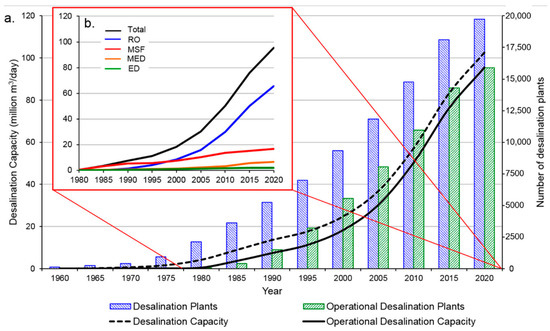
(
) Evolution of desalination capacity and the number of plants across the world over the past 60 years. Inset: (
) comparison of the desalination capacity evolution for four main desalination technologies since 1980 [3].
The well-developed desalination technologies mainly include membrane-based processes (e.g., forward osmosis (FO), reverse osmosis (RO), electrodialysis (ED) and nanofiltration (NF)) and thermal-based processes (e.g., multistage flash distillation (MSF), multi-effect distillation (MED) and thermal vapour compression). Thermal processes, however, are considered to be highly energy-intensive technologies due to their reliance on thermal energy for heating the saline feed and for driving the pumps [4]. In contrast, RO has become the most commonly used technology due to its simplicity and relatively low energy cost. Since 2000, the global desalination capacity has been dominated by RO based desalination plants (
Figure 1b) [3]. Till now, about 80% of the total desalination is derived from RO technology around the world [5]. It could be attributed to the advancement in novel RO membrane materials as well as the reduction in energy consumption and pure water production cost [2,6]. The energy consumption of large-scale RO and MED projects in China was estimated about 4 and 1.5 kWh/m
b) [3]. Till now, about 80% of the total desalination is derived from RO technology around the world [5]. It could be attributed to the advancement in novel RO membrane materials as well as the reduction in energy consumption and pure water production cost [2][6]. The energy consumption of large-scale RO and MED projects in China was estimated about 4 and 1.5 kWh/m
3
, respectively. Depending on the salinity of the feed water, RO processes can be classified into SWRO and BWRO for seawater (SW) desalination and brackish water (BW) desalination, respectively. Generally, BWRO is less energy-consuming and more efficient than SWRO because of the low feed salinity [7].
As of the end of 2019, there were 115 seawater desalination plants all together in China, with a total capacity up to 1,573,760 m
3
/d of potable water (
) [8]. Particularly, in 2019, China set up 17 desalination plants in Liaoning, Hebei, Shandong, Jiangsu, and Zhejiang, respectively, enabling a desalination capacity of about 399,055 m
3
/d. These plants were mainly built to supply the coastal industries, including petrochemical industries, steel industries, fossil plants and nuclear plants, etc. The detailed number and capacity range for local seawater desalination projects in China is depicted in
.
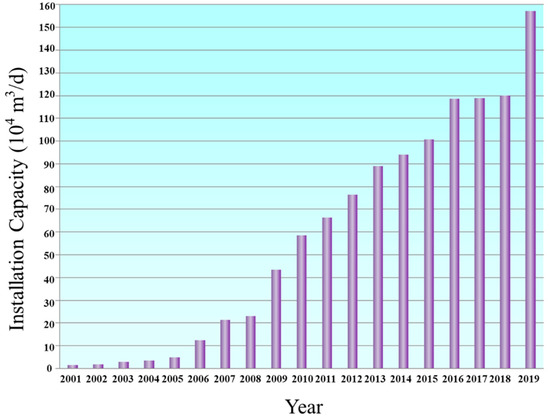
Diagram for the evolution of national seawater desalination capacity over the past two decades in China [8].
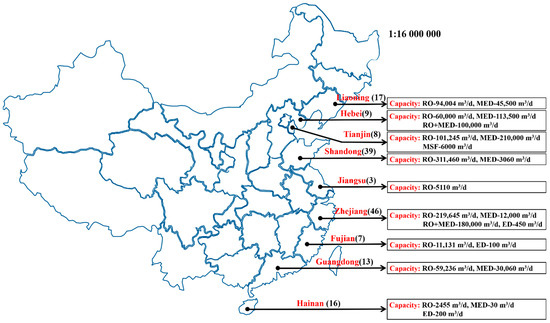
The detailed number and capacity range for local seawater desalination projects in China.
Of all the seawater desalination plants in China, a majority of 97 plants are operated based on RO, possessing a capacity of 1,000,930 m
3
/d, which accounts for 63.6% of the total capacity. The second most popular type is MED plants, the number of which adds up to 15, generating 565,530 m
3
/d water desalination capacity, about 35.9% of the total capacity. There is only one plant that applies the MSF technique, with the capacity of 6000 m
3
/d, in the proportion of 0.38% of the total capacity. Three other plants rely on electrodialysis technique, exhibiting a capacity of 800 m
3
/d, less than 0.05% of the total capacity. Another one is based on FO technique, providing a desalination capacity of 500 m
3
/d, about 0.03% of the total capacity. Over several decades’ evolution, China has gained great progress in desalination industries in terms of products and engineering procurement construction (EPC) companies.
2. The Main Technical Progress
2.1. The Expanded Project Scale and Single Plant Scale
Plant capacity is one of the key indicators of the development degree of the desalination industry. To scale up the plant facility and capacity is highly desirable as larger plants offer the distinct advantages of energy-effectiveness, operational stability, and small footprint. The last 60 years have witnessed the evolution of the seawater desalination capacities of the top 20 plants worldwide, as shown in
[9]. All of the plants had undergone steady increases in the plant capacities, especially the largest one in Sorek in Israel, the capacity of which increased by almost 1000-fold over 60 years (achieved 624,000 m
/day) [10]. It is predicted that the capacity of a single SWRO plant could exceed 1,000,000 m
/d in the future.
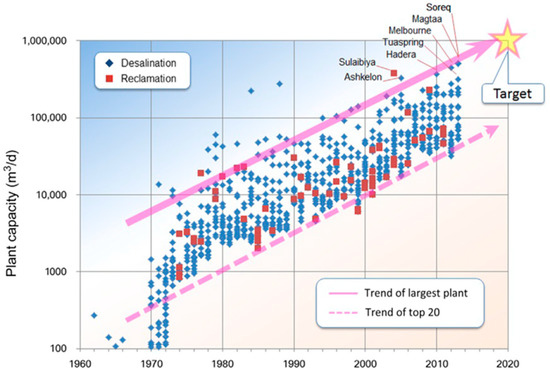
The evolution of plant capacity worldwide over the past 60 years. The solid line shows the trend of the capacity of the largest plant and the dashed line showing that of the top 20 plants [9].
In recent years, China has been devoted to expanding the scale of plants as well. So far, the ≥10,000 m
/d desalination plants have added up to 37, with a total capacity of 1,403,848 m
/d. The number of plants with the capacity in therange of 1000–10,000 m
/d has reached 42, exhibiting a capacity of 162,522 m
/d. There are 36 plants under 1000 m
/d, with the total capacity of 7390 m
/d. In 2019, the capacity of largest newly built desalination plant is 180,000 m
/d.
The representative seawater desalination projects with the capacity of >100,000 m
/d are shown in
. In China, the largest seawater desalination plant of the Beijiang Power Plant MED project owns a capacity of about 2,000,000 m
/d (
a), whilst the largest SWRO plants in five corresponding projects have the capacity of 100,000 m
/d each (
b–f). Notably, Befesa SWRO project is attempting to expand its capacity to 200,000 m
/d in the expectation of becoming the largest SWRO plant in China soon. Moreover, it has become more and more popular to apply the integrated membrane/distillation systems in large plants. For example, in Zhejiang petroleum project, it makes good use of SWRO (75,000 m
/d) and MED (105,000 m
/d) in the integrated system.
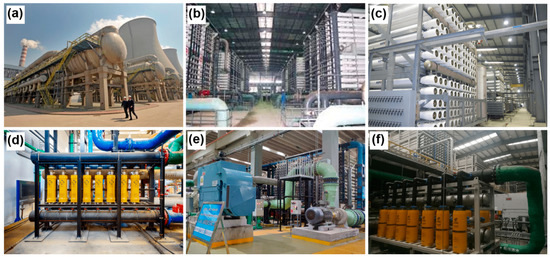
Seawater desalination projects with the capacity of >50,000 m
/d in China. (
) Beijiang Power Plant MED project, Tianjin (200,000 m
/d). (
) Dagang New Spring SWRO project, Tianjin (100,000 m
/d). (
) Caofeidian SWRO project, Tangshan (50,000 m
/d). (
) Befesa SWRO project, Qingdao (100,000 m
/d). (
) Dongjiakou SWRO project, Qingdao (100,000 m
/d). (
) Zhejiang Petroleum SWRO/MED project, Zhoushan (180,000 m
/d).
2.2. The Broadening Application Scenarios and Technical Integration
Apart from seawater desalination, desalination technologies have been widely used in other areas, such as water treatment for municipal and industrial usages. According to the statistic released by The Membrane Industry of Association of China (MIAC), the holding number of RO membrane modules has exceeded 3,500,000 and the installation capacity outnumbered 50,000,000 m
/d (
) [11]. Among them, only about 3% of the capacity was provided to seawater desalination projects (1573,760 m
/d), indicating that RO membranes have been extensively used in many other water treatment projects. Moreover, combination of different desalination technologies has become a new trend for various water treatment scenarios [12][13][14]. For instance, in the project of coal chemical industrial wastewater treatment, RO was coupled with membrane bioreactor (MBR) and MED processes as an integrated system, providing a capacity of 20,000 m
/d.
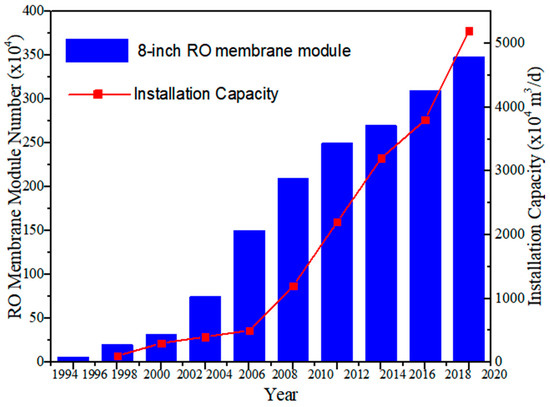
The holding number of RO membrane modules and the installation capacity in China.
The ISDMU of the Chinese Ministry of Natural Resources, has taken over several industrial wastewater treatment projects in recent years (
). Despite the application in seawater desalination, desalination technologies have been applied in a wide range of water treatment applications.
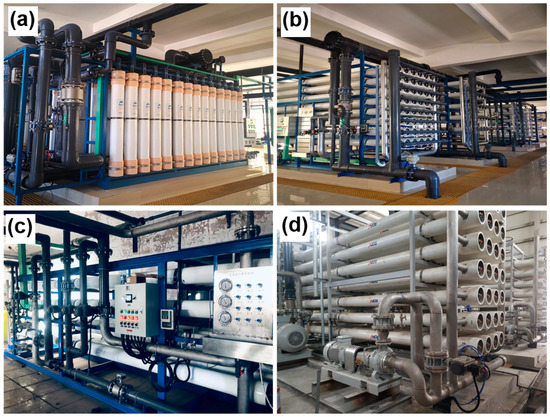
Desalination technologies used in industrial wastewater treatment projects from ISDMU. The ultrafiltration (
) and RO (
) systems for Lianyuan power plant project, Neimeng. (
) Temier power plant project, Neimeng. (
) Tianyu coal chemical industry project, Xinjiang.
On another hand, efforts have been made in the combination of desalination with other energy technologies, such as nuclear power. Seawater desalination is an energy-intensive and/or thermal-intensive process, while nuclear power plants generally rely on excessive consumption of water for cooling and other operations [15]. The integration of seawater desalination and nuclear power plants could be beneficial for each other. Hongyanhe nuclear power plant SWRO project (10,000 m
/d) is the first to demonstrate the practical application of nuclear power and desalination integrated system. After that, SWRO desalination projects have been utilized in other nuclear power plants, such as Ningde, Sanmen, and Haiyang. Recently, researchers from Shandong have proposed an innovative integration idea, named “Co-transport of water and heat”. In their proposal, the product water from the nuclear desalination undergoes certain post-treatment processes first, following heating by the extra heat from the nuclear power plant. Then the heated desalination water was transported to the users, providing heat and clean water simultaneously. Using this proposal, the traditional three pipe systems could be replaced by one single pipe, thereby reducing the operation cost remarkably. The pilot project for water and heat simultaneous transmission has been put into operation, providing water and heat supply for nearly 2000 people at the same time. It provides technical support and demonstration for long-distance heat and water transmission. Additionally, other renewable energy sources such as solar, wind, and geothermal energy have also been considered as an alternative energy supply or desalination [16]. Particularly, solar energy has been widely applied as a heat source or power source for thermal and/or membrane desalination. In China, several solar-driven desalination projects have been implemented. For example, ISDMU has constructed a solar-driven eight-effect plate distillation in Xinjiang (
a) and solar-driven MED in Hainan (
b).
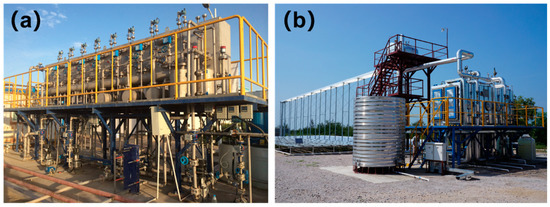
Solar energy driven desalination projects in China. (
) Solar-driven eight-effect plate distillation in Luntai, Xinjiang (MEP, 24 m
/d). (
) Solar-driven low temperature MED in Ledong, Hainan (30 m
/d).
2.3. Further Improved Equipment Series and Strengthened Supporting Capability
Recent decades have seen great progress and advances in the evolution of seawater desalination facilities and capabilities for marine use. Particularly, ISDMU has developed the abilities in equipment series supply based on different utility sites and energy sources, which are classified as ship-based equipment, island-based equipment and all-in-one integrated equipment.
Generally, island-based seawater desalination units are located at remote islands and marine monitoring stations. These instruments should have the advantages of compact structures, less area occupation, easy to install, high automation, easy to operate and maintain. Examples include equipment series in Yongxing island (
a, with a capacity of 1000 and 100 m
/d, respectively), Chenhang island, Lingyang island, Dongmaozhou island, Xiaoqin island and Zhongjian island (with a capacity of 100 m
/d), Lingshan island in Qingdao (
b, with a capacity of 300 m
/d), and Daguan island in Qingdao (with a capacity of 5 m
/d using renewable energy). Alternatively, an all-in-one integrated system has been designed and developed to supply fresh water for remote places with no power or network coverages. With the combination of wind, solar, oil, desalination, and intelligent control systems, such a highly integrated plant has its energy supply systems without the need of additional power resources, thereby showing the advantageous features of energy-effective and highly automated operation (
c). Moreover, a low-temperature tolerable RO equipment realized by integration with thermal devices for extreme conditions, like in the South Pole (
d), was developed.
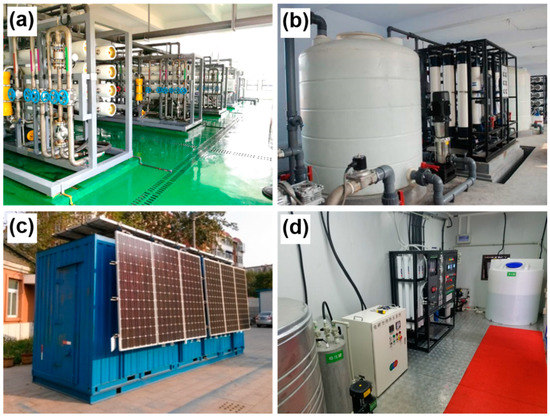
Photographs of some different desalination devices from ISDMU. (
) Yongxing (capacity, 1000 m
/d). (
) Lingshan (capacity, 300 m
/d). (
) The all-in-one system (wind, solar, oil, desalination, and intelligent control integrated into one system). (
) The South Pole (the capacity of 5 m
/d).
Besides, seawater desalination has been extensively employed to generate freshwater to meet the regular need onboard ships (
) [17]. Such devices are designed specifically for ship users, offering the advantages of small size, lightweight, simple installation, and wide adaptability. Plus, the maintenance of these instruments is convenient and time-saving without frequent washing, as the instruments use one-key start/stop allowing the installation/maintenance to be carried out in narrow spaces, such as the cabins, decks, and corridors [17].
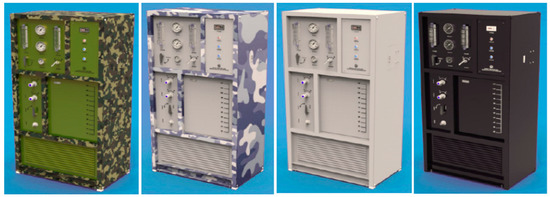
Seawater desalination devices for ship use [17].
ISDMU has also developed chemical reagents for seawater desalination including scale inhibitors, defoaming agents, fungicides, and cleaning agents [18]. Scale inhibitors showed excellent performance, with the antiscale rate at about 95% [18]. The defoaming agents composed of polyether (SD501) and silicone (SD502), exhibited a defoaming rate of >90% at 70 °C without interfering with the scale inhibitors [18]. The developed DM fungicides have the advantages of broad-spectrum and fast sterilization, easy degradation and residual-free. Meanwhile, the cleaning agents are safe, environmentally friendly, as well as compatible with scale inhibitors and fungicide used. These new reagents have been applied in many desalination projects such as Baifa, Yongxing island, Cape Verde, and Djibouti seawater desalination plant.
In the typical SWRO system, pretreatment processes are utilized to ensure all the particulates are removed before the stream reaching the membranes without the incorporation of any strainers [5][19][20]. However, such pretreatment process is sensitive to the changes of source water characteristics, which would lead to a large consumption of processing chemicals, high operational costs and deterioration of environment [21][22]. Thus, it is desired to come up with new processes that allow minimum consumption of chemicals in different application scenarios.
2.4. Improved Research and Development Ability and Technical Level
2.4.1. Core Components and Equipment
Despite the rapid development of seawater desalination technologies in China, the core materials, components, and equipment (e.g., RO membranes, energy recovery devices, and high-pressure pumps) are still cost sensitive on the importation. In recent years, ISDMU has been devoted to the research and development of key devices of desalination based on theoretic improvement, self-developed simulation and domestic materials. For instance, ISDMU developed a series of titanium-based pipelines and its fittings (
a), which showed excellent performances in several tropical island seawater desalination projects, especially the anticorrosive activity [23]. Energy recovery devices and high-pressure pumps were developed with higher efficiency and recovery tolerance (
b,c) [24][25]. The experiences of high-pressure components and the data accumulation of its site applications and cost evaluation will set up new frontier for SWRO material selection.
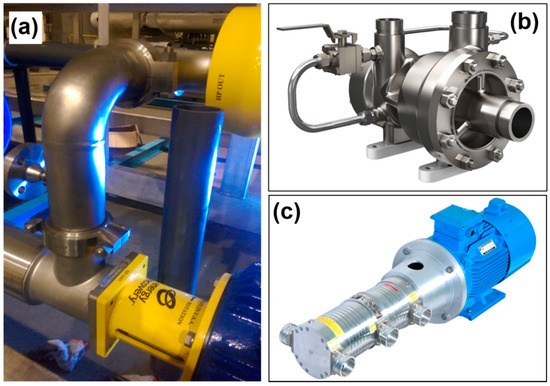
Photographs of (
) titanium-based pipelines and (
,
) high-pressure pumps.
2.4.2. Membrane Materials and Technologies
During a desalination process, the membrane is one of the key elements determining the desalination performance. Generally, there are two main types of desalination membranes, namely ultrafiltration (UF) and RO membranes. However, membrane fouling (e.g., organic fouling, scaling/inorganic fouling, and biofouling) is a major concern in membrane-based applications [26]. For example, scaling could induce extra energy and operational cost in the RO process as a result from the contamination in feed water [27]. Membrane surface modification has been developed to improve the membrane antifouling properties, by physical or chemical methods like nanomaterial penetration, mixing, coating, grafting, self-assembly, chemical coupling, physical adsorption, and irradiation, etc. [26][28][29][30][31].
On another hand, novel membrane material synthesis, module design and processing approaches have been broadly explored, rendering the membranes chlorine-resistant, antifouling, stable, and highly efficient in terms of desalination and separation performance. Interested readers are referred to the excellent research and review articles [32][33][34][35][36][37][38][39][40]. In a recent work by ISDMU and Shandong University of Science and Technology, aminophenyl-modified mesoporous silica NPs were used to fabricate RO membranes, enabling enhanced water flux by 21% while maintaining high NaCl rejection of 98.97%, only slightly decreased by 0.29% compared with that of the pristine membrane [41]. Polytetrafluoroethylene (PTFE) hollow-fiber has emerged as a promising candidate for highly efficient water treatment applications due to its acid-resistant, alkali-resistant and antioxidant properties. Recently, ISDMU has developed a pilot line for PTFE hollow-fiber membranes (HFMs), producing versatile PTFE HFMs with tunable diameters of 0.8–1.5 mm and average pore size 0.28–2.17 µm (
a,c). The self-developed 10-inch module (
b) based on the produced PTFE HFMs yields the capacity of portable water of 140 L/h with a salt rejection of 99.9% in MD desalination. Apart from MD, PTFE HFMs are also widely used for UF desalination. Alternatively, ceramic membranes have been developed with outstanding features of tunable microstructures, excellent chemical and thermal properties, long lifetime, and little environmental impact [42]. Ceramic membranes are mostly used in UF, whilst in some cases, are used in NF and RO desalination applications. Some new types of ceramic membranes made of low-cost geomaterials from nature (i.e., clay, apatite, zeolite, and sand) have become a focus of research interests [43][44][45][46]. For instance, ISDMU has invented novel MFI-type zeolite membranes, for RO desalination applications (
d,e, unpublished work), exhibiting high salt rejection with diminished absorption for hydrated metal ions in saline water.
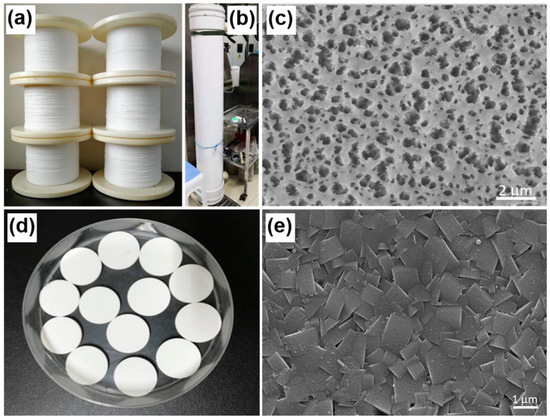
Photographs of (
) PTFE hollow-fiber membrane and (
) the membrane module. (
) Scanning electron microscopy (SEM) surface image of the PTFE hollow-fiber membrane. (
) Photograph and (
) SEM surface image of the MFI-type zeolite membrane (unpublished work).
2.5. Enriched Standard Systems and Technical Services
As of the end of 2019, China had established 166 standards on seawater utilization, including 43 national standards, 116 industrial standards, and 7 local standards. ISDMU is conducting the first ISO standard on the product water of seawater desalination and it is speculated to be released in 2021.
ISDMU is planning to build the seawater desalination innovation base, combining the functions of scientific research, detection and evaluation, product development, reconnaissance design, communication and training, and information integration. In November of 2016, the construction of pilot laboratory started, with the investment of about CNY 0.46 billion for infrastructure and about CNY 0.5 billion for instruments and equipment. This pilot laboratory would provide platforms for seawater resources innovative utilization, including seawater desalination innovative service, island and vessel use small-medium desalination manufacturing, preparation and evaluation of chemical agents, and desalination device monitoring/evaluating platforms. The second phase project would mainly involve the construction of research buildings, testing centers, information centers as well as reconnaissance and design institute, etc.
This project would bring about a series of benefits for the desalination market and industry which entail (1) providing high-end research facilities for breaking the bottleneck technical problems for self-developed products; (2) enabling the third-party evaluation of related products from home and abroad and promoting their market application; (3) offering industry–academia–research innovative centers and attracting excellent research teams from both home and abroad for collaborations; (4) enabling the pilot experiments of the laboratory outcome to facilitate the maturation of the technology; (5) attracting the joining of innovative technologies and personnel to become the center of innovation and one of the world’s competitive desalination industrial communities
References
- Elimelech, M.; Phillip, W.A. The future of seawater desalination: Energy, technology, and the environment. Science 2011, 333, 712.
- Shannon, M.A.; Bohn, P.W.; Elimelech, M.; Georgiadis, J.G.; Mariñas, B.J.; Mayes, A.M. Science and technology for water purification in the coming decades. Nature 2008, 452, 301–310.
- Jones, E.; Qadir, M.; van Vliet, M.T.H.; Smakhtin, V.; Kang, S.-m. The state of desalination and brine production: A global outlook. Sci. Total Environ. 2019, 657, 1343–1356.
- Nassrullah, H.; Anis, S.F.; Hashaikeh, R.; Hilal, N. Energy for desalination: A state-of-the-art review. Desalination 2020, 491, 114569.
- Valavala, R.; Sohn, J.; Han, J.; Her, N.; Yoon, Y. Pretreatment in reverse osmosis seawater desalination: A short review. Environ. Eng. Res. 2011, 16, 205–212.
- Qasim, M.; Badrelzaman, M.; Darwish, N.N.; Darwish, N.A.; Hilal, N. Reverse osmosis desalination: A state-of-the-art review. Desalination 2019, 459, 59–104.
- Ruiz-García, A.; Nuez, I.; Carrascosa-Chisvert, M.D.; Santana, J.J. Simulations of BWRO systems under different feedwater characteristics. Analysis of operation windows and optimal operating points. Desalination 2020, 491, 114582.
- 2019 National Bulletin of Seawater Use. Available online: (accessed on 18 October 2020).
- Kurihara, M.; Takeuchi, H. The next generation energy efficient membrane desalination system with advanced key technologies. In Current Trends and Future Developments on (Bio-) Membranes; Elsevier: Amsterdam, The Netherlands, 2019; pp. 387–406.
- World’s Largest SWRO desalination Plant Operational. Available online: (accessed on 21 October 2013).
- The Membrane Industry of Association of China. 2019–2020 National Bulletin of Membrane Industry Development; The Membrane Industry of Association of China: Beijing, China, 2020.
- Yao, S.; Ji, M. A small RO and MCDI coupled seawater desalination plant and its performance simulation analysis and optimization. Processes 2020, 8, 944.
- Khoshgoftar Manesh, M.H.; Ghalami, H.; Amidpour, M.; Hamedi, M.H. Optimal coupling of site utility steam network with MED-RO desalination through total site analysis and exergoeconomic optimization. Desalination 2013, 316, 42–52.
- Tourab, E.; Blanco-Marigorta, A.M.; Elharidi, A.M.; Suárez-López, M.J. A novel humidification technique used in water desalination systems based on the humidification-dehumidification process: Experimentally and theoretically. Water 2020, 12, 2264.
- Kavvadias, K.C.; Khamis, I. Sensitivity analysis and probabilistic assessment of seawater desalination costs fueled by nuclear and fossil fuel. Energy Policy 2014, 74, S24–S30.
- Alkaisi, A.; Mossad, R.; Sharifian-Barforoush, A. A review of the water desalination systems integrated with renewable energy. Energy Procedia 2017, 110, 268–274.
- Seawater Desalination Equipment Series for Ship Use. Available online: (accessed on 20 April 2020).
- Products: Chemical Reagents for Seawater Desalination. Available online: (accessed on 9 October 2018).
- Abushaban, A.M.J.; Mangal, M.N.; Salinas-Rodriguez, S.G.; Nnebuo, C.; Mondal, S.; Goueli, S.A.; Schippers, J.C.; Kennedy, M.D. Direct measurement of ATP in seawater and application of ATP to monitor bacterial growth potential in SWRO pre-treatment systems. Desalination Water Treat. Sci. Eng. 2017, 99, 91–101.
- Alshahri, A.H.; Dehwah, A.H.A.; Leiknes, T.; Missimer, T.M. Organic carbon movement through two SWRO facilities from source water to pretreatment to product with relevance to membrane biofouling. Desalination 2017, 407, 52–60.
- Kim, J.; Park, K.; Hong, S. Application of two-stage reverse osmosis system for desalination of high-salinity and high-temperature seawater with improved stability and performance. Desalination 2020, 492, 114645.
- Bick, A.; Oron, G. Post-treatment design of seawater reverse osmosis plants: Boron removal technology selection for potable water production and environmental control. Desalination 2005, 178, 233–246.
- Zhao, F.; Wang, C.; Zhou, C.; Liu, S.; Qiu, G. The Utility Model Relates to an Angle Fine-Tuning Device for Seawater Desalination High Pressure Bending Pipe and Its Working Method. Patent China CN111496033A, 2 February 2021.
- Song, D.; Liu, S.; Wang, S.; Chu, X.; Huang, Y.; Jiang, Z. High Pressure Pump Energy Recovery Machine with Adjustable Flow. Patent China CN107829896A, 23 March 2018.
- Liu, S.; Wang, S.; Wang, C.; Song, D.; Wang, H.; Huang, Y.; Qiu, G. The Invention Relates to a Rotating Guide Vane Module Regulated under Hydraulic Working Conditions and an Assembly Method Thereof in a Turbine Pump. Patent China CN110410361A, 5 November 2019.
- Goh, P.S.; Zulhairun, A.K.; Ismail, A.F.; Hilal, N. Contemporary antibiofouling modifications of reverse osmosis desalination membrane: A review. Desalination 2019, 468, 114072.
- Ruiz-García, A.; Feo-García, J. Estimation of maximum water recovery in RO desalination for different feedwater inorganic compositions. Desalination Water Treat. 2017, 70, 34–35.
- Ruiz-García, A.; Melián-Martel, N.; Mena, V. Fouling characterization of RO membranes after 11years of operation in a brackish water desalination plant. Desalination 2018, 430, 180–185.
- Ahmed, F.E.; Hashaikeh, R.; Hilal, N. Fouling control in reverse osmosis membranes through modification with conductive carbon nanostructures. Desalination 2019, 470, 114118.
- Melián-Martel, N.; Sadhwani Alonso, J.J.; Ruiz-García, A. Combined silica and sodium alginate fouling of spiral-wound reverse osmosis membranes for seawater desalination. Desalination 2018, 439, 25–30.
- Karabelas, A.J.; Mitrouli, S.T.; Kostoglou, M. Scaling in reverse osmosis desalination plants: A perspective focusing on development of comprehensive simulation tools. Desalination 2020, 474, 114193.
- Johnson, D.J.; Hilal, N. Can graphene and graphene oxide materials revolutionise desalination processes? Desalination 2021, 500, 114852.
- Alihemati, Z.; Hashemifard, S.A.; Matsuura, T.; Ismail, A.F.; Hilal, N. Current status and challenges of fabricating thin film composite forward osmosis membrane: A comprehensive roadmap. Desalination 2020, 491, 114557.
- Alnoor, O.; Laoui, T.; Ibrahim, A.; Kafiah, F.; Nadhreen, G.; Akhtar, S.; Khan, Z. Graphene oxide-based membranes for water purification applications: Effect of plasma treatment on the adhesion and stability of the synthesized membranes. Membranes 2020, 10, 292.
- Anis, S.F.; Hashaikeh, R.; Hilal, N. Functional materials in desalination: A review. Desalination 2019, 468, 114077.
- Yao, Y.; Zhang, P.; Jiang, C.; DuChanois, R.M.; Zhang, X.; Elimelech, M. High performance polyester reverse osmosis desalination membrane with chlorine resistance. Nat. Sustain. 2021, 4, 138–146.
- Han, H.; Dai, R.; Wang, Z. Fabrication of high-performance thin-film composite nanofiltration membrane by dynamic calcium-carboxyl intra-bridging during post-treatment. Membranes 2020, 10, 137.
- Anis, S.F.; Hashaikeh, R.; Hilal, N. Reverse osmosis pretreatment technologies and future trends: A comprehensive review. Desalination 2019, 452, 159–195.
- Ahmed, F.E.; Hashaikeh, R.; Hilal, N. Hybrid technologies: The future of energy efficient desalination—A review. Desalination 2020, 495, 114659.
- Kim, N.; Lee, J.; Kim, S.; Hong, S.P.; Lee, C.; Yoon, J.; Kim, C. Short review of multichannel membrane capacitive deionization: Principle, current status, and future prospect. Appl. Sci. 2020, 10, 683.
- Wang, J.; Wang, Q.; Gao, X.; Tian, X.; Wei, Y.; Cao, Z.; Guo, C.; Zhang, H.; Ma, Z.; Zhang, Y. Surface modification of mesoporous silica nanoparticle with 4-triethoxysilylaniline to enhance seawater desalination properties of thin-film nanocomposite reverse osmosis membranes. Front. Environ. Sci. Eng. 2019, 14, 6.
- Elomari, H.; Achiou, B.; Ouammou, M.; Albizane, A.; Bennazha, J.; Alami Younssi, S.; Elamrani, I. Elaboration and characterization of flat membrane supports from Moroccan clays. Application for the treatment of wastewater. Desalination Water Treat. 2016, 57, 20298–20306.
- Das, R.; Sondhi, K.; Majumdar, S.; Sarkar, S. Development of hydrophobic clay–alumina based capillary membrane for desalination of brine by membrane distillation. J. Asian Ceram. Soc. 2016, 4, 243–251.
- Abo-Almaged, H.H.; Gaber, A.A. Synthesis and characterization of nano-hydroxyapatite membranes for water desalination. Mater. Today Commun. 2017, 13, 186–191.
- Zhu, B.; Hong, Z.; Milne, N.; Doherty, C.M.; Zou, L.; Lin, Y.S.; Hill, A.J.; Gu, X.; Duke, M. Desalination of seawater ion complexes by MFI-type zeolite membranes: Temperature and long term stability. J. Membr. Sci. 2014, 453, 126–135.
- Alftessi, S.A.; Othman, M.H.D.; Adam, M.R.; Farag, T.M.; Ismail, A.F.; Rahman, M.A.; Jaafar, J.; Habib, M.A.; Raji, Y.O.; Hubadillah, S.K. Novel silica sand hollow fibre ceramic membrane for oily wastewater treatment. J. Environ. Chem. Eng. 2021, 9, 104975.
